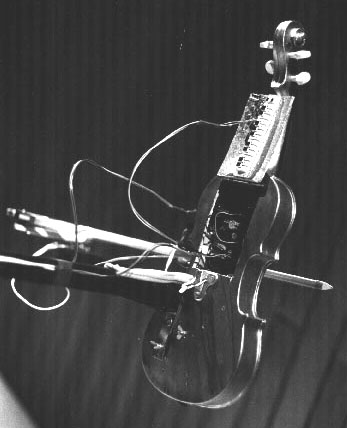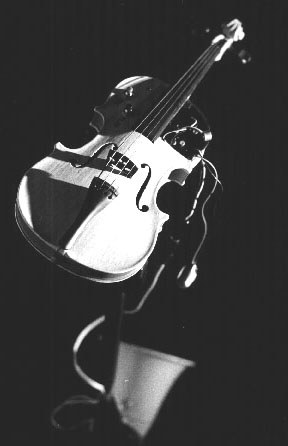|
|
in today's world of packaged easy listening it
is hardly surprising that some of the major innovators of 20th century music
slip through the information net - particularly if they don't live in the
northern hemisphere. take jazz music for example. a careful perusal through
leonard feather's
encyclopedia of jazz
reveals absolutely no mention
at all of the legendary australian jazz violinist
jo doc' rosenberg
.
first, a few biographical notes -
his birth date is not sure, but he
reckons to be in his middle 70s and was born in wagga wagga, new south wales.
he was the younger of two very talented brothers - the other, johannes,
went on to become a famous violinist and composer. their father was thought
to have been a zeppelin sales representative who emigrated to australia
in 1918 - a somewhat depressed personality
.

while his brother was building an international
reputation, doc' stayed home and practised his scales. he was first employed
as a camel consultant for qantas (queensland and northern territory air
service) - at this time camels were used in australia rather like hire cars
today. it was with this means of transport that rosenberg escaped to the
northern territory in the early 40s to avoid military service. he took his
violin with him and was soon transcribing complicated rhythmic passages
from the aboriginal musos (musicians). by day he developed his unique spiccato
bow strokes (later used in
boo rhythmics
and by night he played in
a country and western band,
the howling crocodiles
. until recently
jazz always considered itself as primarily an oral tradition with great
emphasis placed on the practice of improvisation. australia can boast the
(just about) continuing tradition of the world's oldest oral music tradition
- that of the aborigines. and what perhaps is the most important component
of an improvising tradition? probably memory. it has been recorded that
some aboriginal elders in the early 1800s had a repertoire of over 7,500
songs (cf.
early contacts'
j.hudson). this ability to store and recall
information in the brain is clearly a lost technique. of course, our personal
computers can do it for us now - however, we find it almost impossible to
function without our information technology. it was the technique of aboriginal
memory that became the basis for rosenberg's
boo theory
.
in the northern territory, in the late 40s, rosenberg
spent a lot of time with
jimmy mobano
, an aboriginal elder. he learnt
that song memory relied on the ability to locate each song under a certain
rock (or other geographical feature). it was by going walkabout' in the
brain that each singer could enjoy a huge repertoire. this concept went
hand in hand with the full realisation that the history of music was not
developmental and linear in structure, but was linked by a network of
geographical
addresses. speed and reliability of finding each song depended on
brain
weather
and not chronological time. in this way it was quite with the
realms of possibility (if not to say probability) to access the work of
other musicians from other times. the greeks would have us believe that
simonides invented the art of memory' - but those in the south know different!
what rosenberg needed for his theory though was
some kind of cosmic glue that would be flexible and elastic enough to bring
the location principles of
boo
into any defined musical language
- no matter how trivial (eg the western diatonic tone system). scale, then
was the immediate problem. for many years, rosenberg had been fascinated
by the similarities between the violin bow and the boomerang. as the sassel's
new english dictionary states -
boo'me rang
:
a native australian
missile weapon, consisting of a curved stick up to a metre long so constructed
that, thrown forward, it takes a whirling course upwards, returns with a
swoop, makes a weird buzzing sound, and eventually hits the thrower right
on the nose if it hasn't been correctly thrown in the first place, (fig.)
an action, speech, or argument that recoils on the person who makes it.
just like the violin bow, rosenberg had realised. successive experiments
and substantial measurements on the ground and in space gave the violinist
a workable formula with which to take any perceivable music language forwards,
backwards, upwards, sideways and yes, around in circles. in 1957 rosenberg
had
boo theory
broken down into 1040 more useful formulas. on a bright
clear day, with a north east wind, he decided to concentrate on one which
he kept under a large monolith rock called mooloo near ula ula. by chance
it dealt with a relatively short period of chronological time called modern
jazz. he decided that this style of music was as good as any to test
the
boo
. in the 50's, like all jazz musicians in australia, rosenberg worked
in restaurants and clubs for a living (a tradition that continues to this
very day). recordings from this period show that the violinist had no trouble
jumping forwards and back over three or four decades (one can hear, however,
a few bowing uncertainties when travelling in the direction modal to bebop
to mainstream to free). but leaving the uncertainty principle' aside, it
is obvious that
boo melodic
(as it became known) out-theorises all
the later theories such as the lydian chromatic and the harmolodic -indeed
all of them can be accommodated under any monolith in the northern territory.
a good example of early rosenberg can be heard on the album
forward of
short leg
(dossier st 7529) - a version of blue moon' recorded live
at the blacktown workers' club. this is an excerpt from the national sound
library, canberra - one wonders how much more of this rare material actually
exists!

with rosenberg's blacktown workers' club appearances,
there started an endless succession of legal battles with the musician's
union and the keep music live' campaign. after a period of confinement with
hard labour', the doc' found employment at don's restaurant in broken hill.
for his next term inside prison, the violinist put
boo melodics
into
an interesting variation form. the walkabout' this time involved the violinist
going from restaurant table to restaurant table - each table in a different
time and place - but all inside his head. by the end of this third term
inside prison, rosenberg had memorised 4,190 restaurant tables - an
extraordinary
feat of self discipline and brain management well beyond the powers of the
average jazz practitioner. some of these tables can be heard on a recently
released c.d.
violin music for restaurants
(rer megacorp, london.)
|
|

